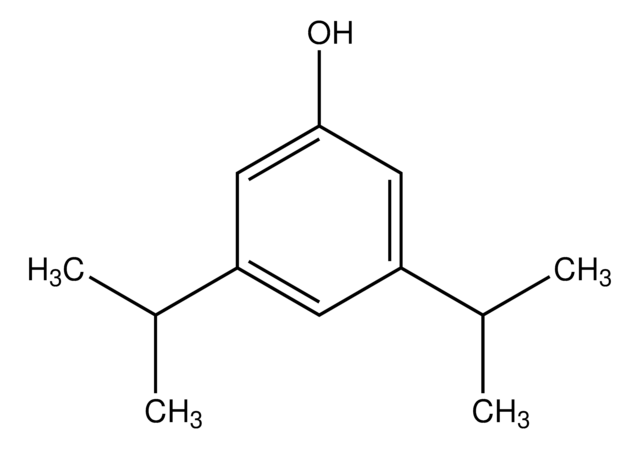W505102
2,6-Diisopropylphenol
≥97%
Sinónimos:
2,6-Bis(1-methylethyl)phenol, 2,6-Bis(isopropyl)phenol, Propofol
About This Item
Productos recomendados
origen biológico
synthetic
presión de vapor
5.6 mmHg ( 100 °C)
Ensayo
≥97%
índice de refracción
n20/D 1.514 (lit.)
bp
256 °C/764 mmHg (lit.)
mp
18 °C (lit.)
densidad
0.962 g/mL at 25 °C (lit.)
aplicaciones
flavors and fragrances
cadena SMILES
CC(C)c1cccc(C(C)C)c1O
InChI
1S/C12H18O/c1-8(2)10-6-5-7-11(9(3)4)12(10)13/h5-9,13H,1-4H3
Clave InChI
OLBCVFGFOZPWHH-UHFFFAOYSA-N
Información sobre el gen
human ... CYP1A2(1544) , GABRA1(2554)
rat ... Gabra2(29706)
¿Está buscando productos similares? Visita Guía de comparación de productos
Palabra de señalización
Warning
Frases de peligro
Consejos de prudencia
Clasificaciones de peligro
Acute Tox. 4 Oral - Eye Irrit. 2 - Skin Irrit. 2 - STOT SE 3
Órganos de actuación
Respiratory system
Código de clase de almacenamiento
10 - Combustible liquids
Clase de riesgo para el agua (WGK)
WGK 3
Punto de inflamabilidad (°F)
235.4 °F - closed cup
Punto de inflamabilidad (°C)
113 °C - closed cup
Equipo de protección personal
Eyeshields, Faceshields, Gloves, type ABEK (EN14387) respirator filter
Elija entre una de las versiones más recientes:
¿Ya tiene este producto?
Encuentre la documentación para los productos que ha comprado recientemente en la Biblioteca de documentos.
Los clientes también vieron
Nuestro equipo de científicos tiene experiencia en todas las áreas de investigación: Ciencias de la vida, Ciencia de los materiales, Síntesis química, Cromatografía, Analítica y muchas otras.
Póngase en contacto con el Servicio técnico















